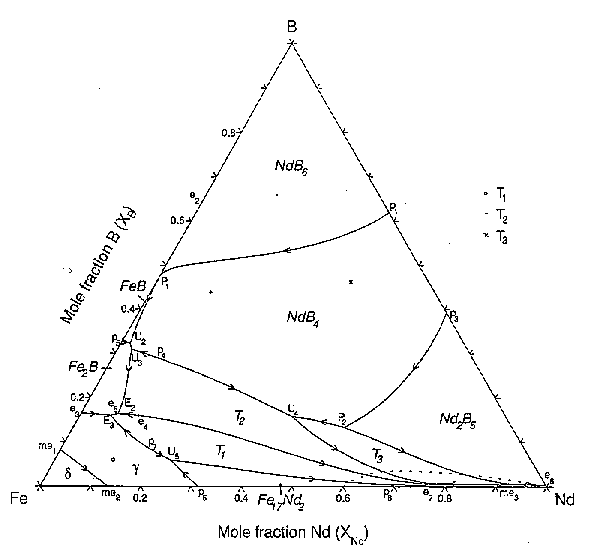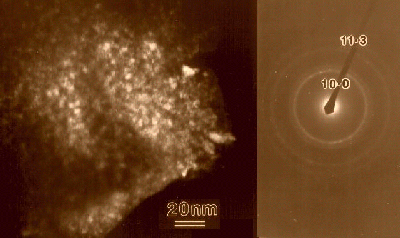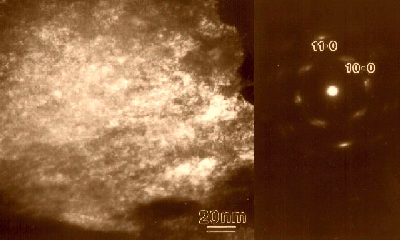The Neodymium-Iron-Boron Application
A very exciting and important field of study in Materials Science is that of magnetic materials. Natural magnets in the form of Lodestone mystified people for thousands of years, but with today's scientific theory, technology, and the use of phase diagrams, we can fully explain, predict, and develop new materials with desired magnetic properties. One example is the Neodymium-Iron-Boron magnet which was developed in 1984 and is the strongest permanent magnet of our time (Parker 2).
In a permanent magnet, each atom produces a net magnetic field caused by its unpaired electrons. Since there are so many of these aligned atoms in the material, the overall magnetic field is amplified to observable levels. Some materials show evidence of partial magnetic attraction or repulsion under the influence of an outside magnetic field. However, the ability of a material to maintain the magnetic dipole (orientation) in the absence of an outside magnetic field is ferromagnetism, which is the essence behind permanent magnets (Callister 666).
A magnet's properties of remanence, coercivity, Curie Temperature, and BH product often characterize its strength and general application potential. The remanence of a ferromagnetic material is the magnitude of the magnetic field that the material can sustain when it is no longer subject to an external magnetic field (Callister 674). The coercivity of a permanent magnet is its ability to maintain its magnetic field in an external field applied in the reverse direction (Callister 674). As the temperature of a material increases, the particles begin to excite and move randomly; this effect can destroy the magnetic properties of a permanent magnet. The temperature at which the magnet loses its properties is different for each material and is called the Curie temperature (Callister 671). The BH product is the multiplication of the remanent magnetic field and the coercive magnetic field required to reduce the remanence to zero. This quantity describes the energy of a volume of magnetic material (Callister 677).
Using these properties, it is easy to compare the pros and cons of Nd-Fe-B magnets. While the magnetic properties of the Nd-Fe-B magnets are outstanding, Neodymium magnets possess a low Curie temperature. This quality is a major factor in determinining their overall usability. For instance, even though at room temperature they demonstrate unequaled strength, in a working machine environment where the temperature exceeds 320Co (the Curie temperature for Neodymium magnets), the superior qualities would diminish. With the use of phase diagrams, studies which have been conducted on different alloys of Nd-Fe-B showed that using the sintering method for producing the Nd2Fe14B magnet, created unstable magnetic properties at elevated temperatures. The study also showed that a magnet with a higher Curie temperature might be produced with Fe-Nd-C using a process such as melt-spinning. Below, is The Ternary Phase Diagram for the Fe-Nd-B system. Using this diagram, scientists are currently researching the possibility of Fe17Nd5 magnets, and Fe-Nd-B-X phases.

(The information and TEM micrographs from the following two paragraphs was taken from "A TEM-EDXS Study of Zirconia doped Nd-Dy-Fe-B Magnets Fabricated from the HDDR Processed high Coercivity Powders")
One method of producing highly coercive Nd-Fe-B magnets is the HDDR process in which Nd2Fe14B is produced by combining alloys of NdFe, DyFe, FeB, Fe powder and ZrO2 in an oxygen free atmosphere. Next, the alloy is treated in hydrogen at temperatures around 800Co for two hours. Finally, the sample is crushed into a powder. The addition of small amounts of ZrO2 has been shown to produce anisotropic grain growth in the Nd2Fe14B phase. This strongly increases the magnetic properties of the material. Below, and to the left, is a TEM micrograph of a sample of the Nd-rich phase without the ZrO2. The bright spots represent collections of crystals as large as 5nm. The picture to the right is a Selected Area Electron Diffraction (SAED) pattern. The circles with uniform contrast show that the "crystallites" are randomly oriented.

Fig. 1. (a.) - Dark field TEM micrograph and (b.) - selected area electron diffraction (SAED) pattern of the Nd-rich
particle in powder sample without ZrO2 after the hydrogenation at 770 C.
This TEM and SAED are for a sample that contains one percent by Weight ZrO2. The crystals in the sample are as large as 20nm and the brightness of the sample is an easy indicator that the amount of crystalization of the Nd-rich phase is far greater than the last sample. The SAED pattern shows arcs that indicate random orientation rather than spots that are characteristic of aligned grains.

Fig. 2. (a.) - Dark field TEM micrograph and (b.) - SAED pattern of the Nd-rich particle in powder sample with 1 wt.
% ZrO2 added after the hydrogenation at 770°C.
In the processing of the magnet, the powder is oriented in an external magnetic field, while heated and compressed. During this process, the excess Nd and B diffuse into the grain boundaries, thus leaving behind the highly magnetic Nd2Fe14B. The finished product can have BH products as high as 400Kj/m3!
Nd2Fe14B permanent magnets have been used for many different and important applications such as small motors, loudspeakers, communications, and power generators. In fact, it was these very magnets that dropped the size of a 1 meg. hard drive from 16" in diameter to 1.8" in diameter! For these reasons, there has been an enormous market for permanent magnets in recent years (Mitchell 190). With the use of phase diagrams and present technology, Materials Scientists are researching methods to increase the Curie Temperature of the Neodymium Iron Boron magnet, without sacrificing the superb magnetic qualities. Great success has not yet been obtained, but if the material was improved, it would replace permanent magnets in almost all applications for which we use them today. Because the Neodymium magnet is so strong, smaller amounts of it would have to be used to replace an existing magnet in a motor or electronic device. This would produce a much more efficient and compact electronic device, and further improvements would surely follow that would revolutionize the use of permanent magnets in all phases of technology.
Garrett Storaska 4/28/96
http://www.eng.vt.edu/eng/materials/classes/MSE2094_NoteBook/
96ClassProj/examples/neodym.html
Project Homepage | Examples/Applications Page


